Moto G10 Review
Moto G10 Review
No longer the king
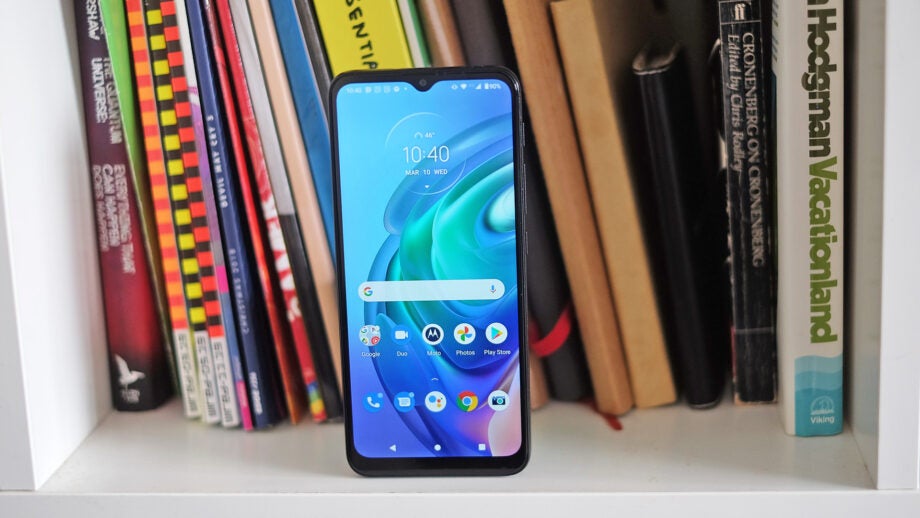
Verdict
The Moto G10 is a decent buy for those who want a cheap phone that lasts a long time between charges. Others might be better off spending a little more on alternatives from Realme or Xiaomi. This phone feels a little slow and its main camera often produces drab, oversharpened images.
Pros
- It’s cheap
- Has a half-decent (mono) speaker
- Two-day battery life
Cons
- Poor primary camera image processing
- Noticeable performance compromises
Key Specifications
- Review Price: £129
- 6.5-inch 1600 x 720 IPS LCD
- 5000mAh battery
- 4GB RAM
- 64GB storage
- 48/12/2/2MP rear cameras
- 8MP front camera
- 165.22 x 75.73 x 9.19mm
- 200g
Don’t expect miracles with the Moto G10. It feels noticeably slower than the main-line Moto G9 phones, even when you’re simply milling around in Android 11.
The Moto G10’s cameras are uninspiring, too, especially when compared to some of the other best cheap phones around. Its main sensor takes cold and somewhat dull-looking images most of the time.
This handset is only really a good option for people who don’t spend much time with their phone, using it just for the basics. And with that in mind, the Moto G10 offers exceptional battery life, easily lasting a full two days for many people.
Price and availability
The Moto G10 is Motorola/Lenovo’s main ultra-low-cost phone for early 2021. It costs £129.99/€149/roughly $180. The phone isn’t available in the USA.
That’s less than the Moto G30, which we mostly like.
Moto G10 design and screen – Everything is just fine
- Low-spec display, but the quality is fine
- So-so max screen brightness
- 720p resolution isn’t an issue at this price
I often talk about budget phones that pull off a pretty good impression of expensive handsets for design and performance. They’re the phones I believe most people should actually buy.
The Moto G10 belongs to a league below, where the aim isn’t so much as to fool us, but to present a device that isn’t completely boring.
A wavy plastic rear does the job here. And this isn’t a finish that sits below a flat top layer. The plastic is actually contoured, like the sands of a wind-swept desert.
At first glance, I wasn’t convinced. But it feels quite nice to the touch since the peaks of these dunes are soft – not sharp, as they may appear in photos.
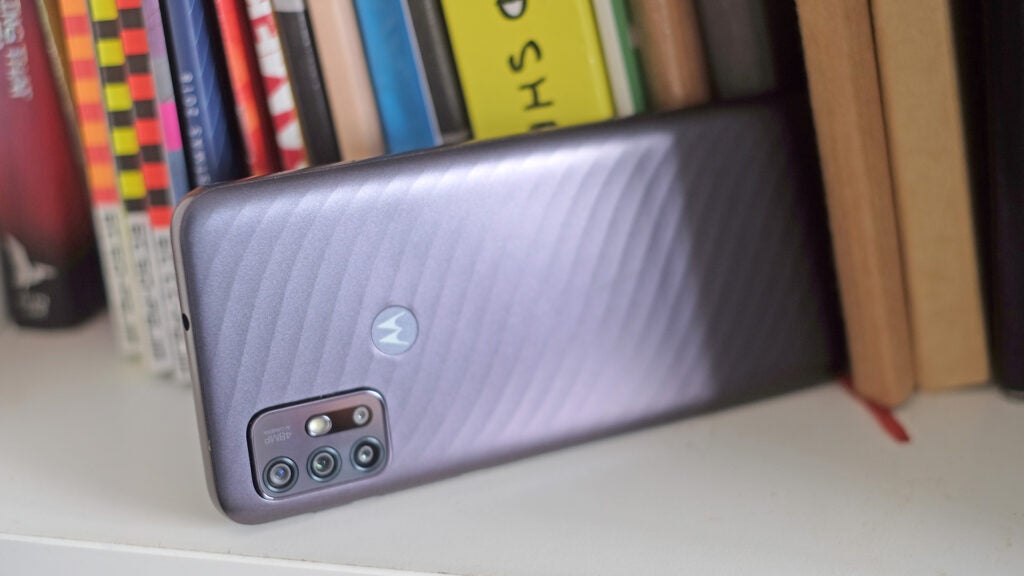
However, there’s almost no contouring to the rear fingerprint scanner, making it tricky to find blind. It’s another reason to use the included silicone case, alongside drop protection.
The fingerprint scanner here is a little slower than most, but otherwise works well. You even get IP52 water-resistance, equivalent to light splash-proofing, which is nice to see at the low price.
The Moto G10 also surprises for the quality of speaker. At this price, the norm is pretty dreadful thin-sounding units – but this one offers the reasonable volume and tone found in the rest of the Moto range.
There’s only get one driver at the bottom, though, making the device better for listening to podcasts over watching YouTube videos or playing games.
The Moto G10 screen measures 6.5 inches across, which is a good size, with a resolution of 1600 x 720 pixels.
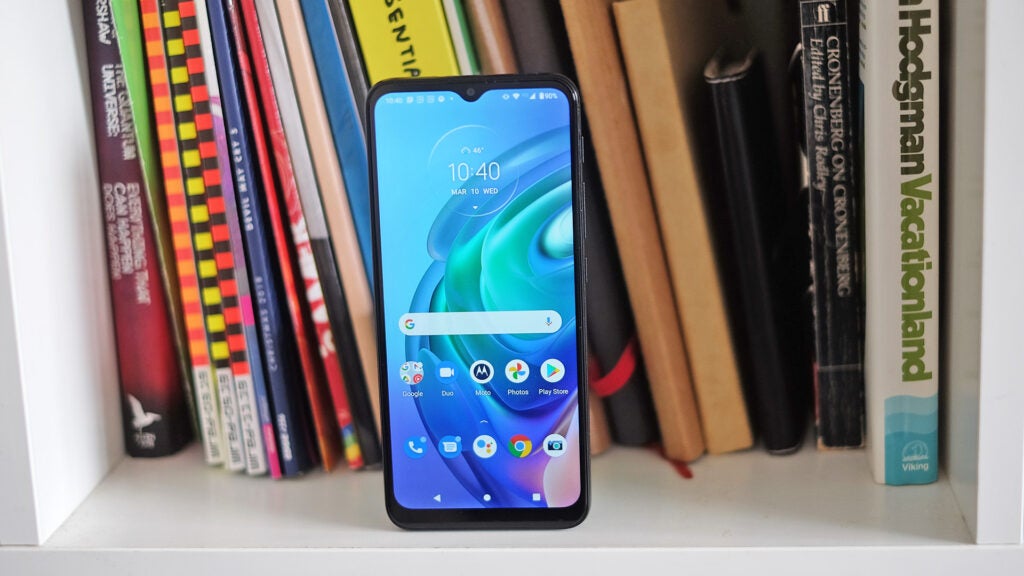
The screen here, like almost every panel in a cheap phone, looks good despite the low specs. But compare it to the screen of a phone from a tier or two above, and you’ll notice some differences.
The Moto G10 doesn’t offer super-deep, rich colour – even if you use its “saturated” mode. Plus, the 720p resolution means you can see a tiny amount of pixellation if you go looking for it.
With a standard 60Hz refresh rate, the panel here doesn’t appear as smooth as the Realme 6’s 90Hz LCD.
However, while I get the opportunity to try all kinds of high-end phone displays, there’s only one shortfall that really grates having used the Moto G10 for a couple of weeks. Its maximum brightness of 384 nits.
I tested this using a colorimeter and an LED array to simulate bright conditions. But the fact that this isn’t the clearest screen outdoors had already become apparent beforehand on several occasions, particularly when taking photos.
Moto G10 camera – It looks better on paper
- Poor processing lets down hardware that looks good on paper
- Stabilised 1080p video
- Soft selfies
The Moto G10’s camera array looks swish. Four lenses sit in a compact glass rectangle, the sort of design you might have seen in a super-expensive phone just a couple of years ago.
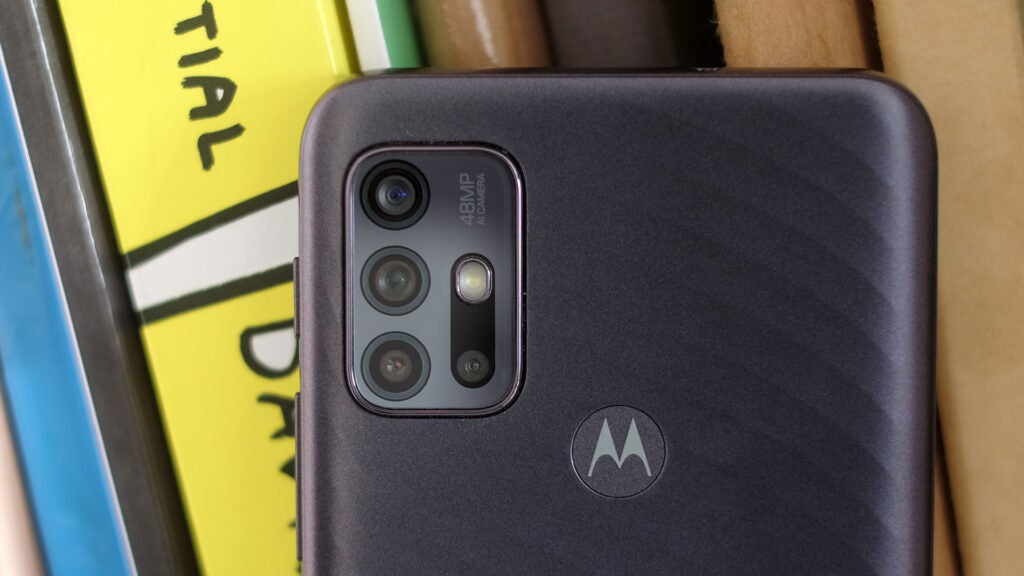
But the results? I’m not all that impressed by them, and they certainly aren’t comparable to the best camera phones around, even those handsets at this price.
The main 48-megapixel camera tends to oversharpen images, spitting out overly cool-looking photos that verge on undersaturation. Its processing character is disappointing, leading to “crispy”-looking natural textures and unnatural outlines around objects, caused by all that image sharpening.
Shots of scenes in mixed lighting also end up looking quite dull, despite the Moto series’ solid HDR algorithms. These brighten up dark areas in an image to bring out greater detail.


Unusually, the Moto G10’s ultra-wide camera often shoots photos that are appealing, displaying warmer, more vibrant colours and less obvious evidence of sharpening. And this despite the ultra-wide camera having less to work with, since it uses a lower-resolution 12-megapixel sensor that you’d assume is weaker.

Such borderline ugly processing isn’t the norm for Moto phones. I dug out a 2016 Moto G 4th generation device to see if there was actually any real progress here.
The Moto G10’s dynamic range is better, as a result of the improvements in HDR processing over five years. But the Moto G4 arguably produces the more natural image, with none of the over-the-top sharpening seen on images taken with the new phone.
As such, I don’t think it’s necessarily the core camera hardware at fault here, but what the Moto G10 does with it. And most of the criticisms only apply to the phone’s primary camera. The 12-megapixel wide produces smoother images with a more pleasing colour tone. There’s the usual secondary budget camera effect: that ultra-wide images are quite soft and relatively low in detail.
The Moto G10 also has two other cameras. There’s a 2-megapixel macro, which is pretty poor; it doesn’t have the resolution to actually render fine details with the clarity that makes macro photos stand out. The final 2-megapixel sensor is used as a depth aid for background blur in Portrait mode.
This doesn’t create particularly good depth maps, leading to parts of the background that should be blurred appearing sharp. But it lets you use the Portrait more for any object, not just people.
The Moto G10 only shoots video at 1080p. Its image quality is uninspiring and the exposure seems to bob up and down awkwardly with some scenes. But it’s at least stabilised, making it somewhat usable.
Night Vision redeems the Moto G10, slightly. This is the Moto’s low-light photo mode. It takes a few seconds to shoot an image, several more to process it, but it dramatically improves brightness, visibility and dynamic range. Night Vision shots also side-step the sharpening issue of the Auto mode.
Sure, they’re soft and not a match for the night photos of a good sub-£300 phone such as the Xiaomi Redmi Note 10 Pro, but it’s nice to see Lenovo put Night Vision in a phone at this price.
Our front camera has an 8-megapixel sensor, and – no surprise here – it takes fairly poor selfies. They look soft and there’s no autofocus.
The Moto G10 doesn’t have a good camera array, but it’s mostly let down by a fumbled implementation of the main 48-megapixel sensor. Shooting also feels quite sluggish, with some shutter lag and long processing waits if, for example, you shoot a photo in WhatsApp rather than the camera app (where the processing happens in the background).
The in-app preview image is also dreadfully dark, even with max screen brightness – because, unlike a higher-end phone, the Moto G10 doesn’t estimate what the final image will look like as you compose a shot.
Moto G10 performance – You get what you pay for
- Feels slower than phones only a level up the scale
- Can play plenty of games, but Fortnite runs poorly
The Moto G10’s slow image processing is likely in part the result of the phone’s Snapdragon 460 chipset. This is a low-end Qualcomm chipset with eight cores. Most Moto-series phones use CPUs from the step-up 6-series range.
It performs well enough in some areas, but not so well in others. Unfortunately, one of the compromises is quite obvious.
The Moto G10 doesn’t feel all that nimble in Android, around parts of the interface and between the simple apps most of us use daily.
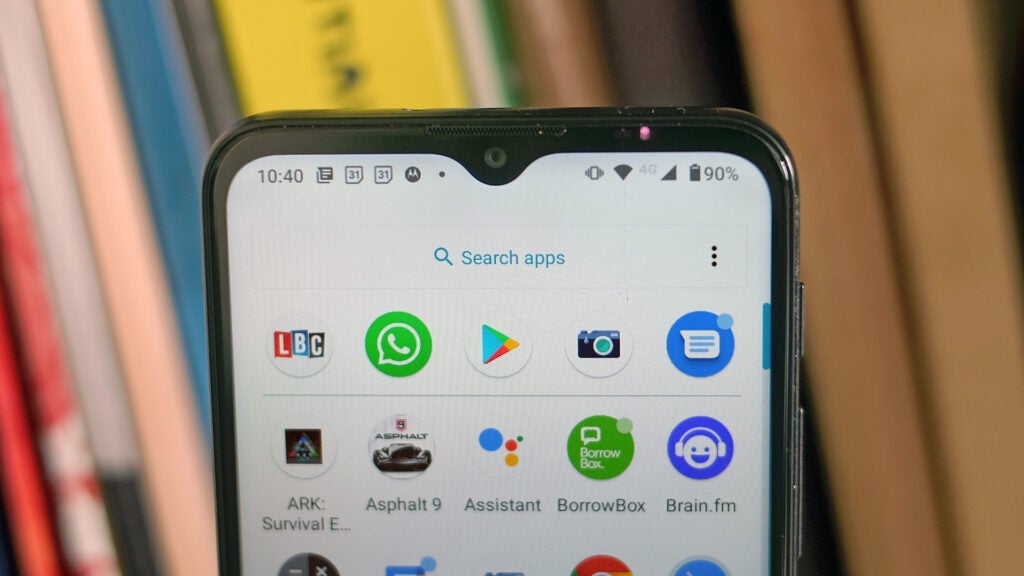
Slight pauses here and there, the sub-second waits as a blank screen is populated with the Settings menu, are reminders that this is a cheap phone. There’s less of this in the Moto G30, or the Xiaomi Redmi Note 9, which sells at the same price as the Moto G10 nowadays.
The Moto G10 can play PUBG just fine; Asphalt 9 runs okay at default settings, bar the odd full-on pause that seems to affect almost every genuinely cheap phone when playing this game. ARK: Survival Evolved runs fine, too, without reducing in-game detail to a great degree – in fact, plenty of budget phones don’t support this game at all since it requires support for graphics standard Vulkan API.
The phone scores 1111 points in Geekbench 5 (248 per core). This may not sound too much lower than the 1300-odd of the Moto G30, but there’s a real-world impact.
As such, it would be enough to persuade me to perhaps spend a little more, or opt for another brand – although the lag isn’t so infuriating to make you want to flush your phone down the toilet. The Moto G10 isn’t unbearably slow, it just isn’t hugely responsive. My issue is that you don’t have to pay all that much more for such zip these days.
Fortnite runs – but don’t bother trying it. Even at the lowest possible setting, dips to single figure frame rates were common, making it more-or-less unplayable unless you want to return to a dead character following a fps dip.
The Moto G10 could be a worse gaming phone; Qualcomm’s Snapdragon 460 performs better than some entry-level MediaTek chips. But you can get better results by spending just a little more money.
Moto G10 battery life – The shining star
- Two-day use is a reality
- USB-C charging
- Slow 10W charger included
I’ve shown you, at best, a mixed view of the Moto G10 so far. However, battery life is the best reason to hold on through the issues.
The Moto G10 comes with a 5000mAh unit – and it works wonders in partnership with the low-power CPU.
I have frequently been left with 50% battery life by bed time. It’s one of the very best results I’ve seen in the past 12 months.
Sometimes I find that low-power phones achieve such great battery life figures because poor performance has meant that I use them less. But that isn’t the case with the Moto G10. We’re talking about 50% charge loss after a full 17 hours of normal use.
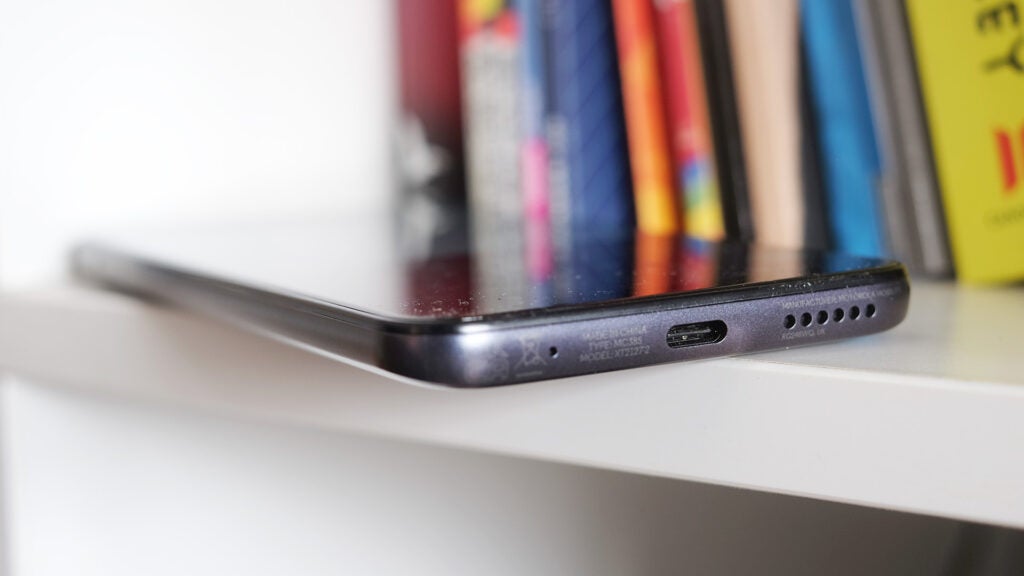
So, battery life is long – but charging time is slow since you get only a 10W charger in the box. However, this arguably matters less in a phone you probably won’t need to top-up through the day.
Moto G10 Conclusion
I often recommend Moto phones. They tend to get the basics right, and are rarely overpriced. You’ll find they consistently feature in both our best phone and best mid-range phone lists.
The Moto G10 isn’t such a device, though. Despite offering exceptional battery life and a screen that looks pleasant, the Moto G10’s performance compromises are sufficient to warrant spending a little more on the Moto G30 – or switching to the similarly priced Xiaomi Redmi Note 9 instead. Camera image processing leaves a lot to be desired, too.
You should buy the Moto G10 if…
- You want a phone with a two-day battery
The Moto G10’s top feature is that it lasts as long (or longer, in some cases) than phones in the G Power line, which have bigger batteries. Its 5000mAh battery lasts up to two days, and with moderate rather than super-light use.
- You just want a cheap phone for the basics
A low price is the main draw of the Moto G10 – and, unlike some cheap phones, it isn’t completely devoid of personality thanks to its wavy back. The screen leaves a good impression as well, if your expectations aren’t set too high.
You shouldn’t buy the Moto G10 if…
- You expect top performance
The Moto G10 isn’t a hugely powerful phone. Its performance isn’t so bad you’re likely to regret buying it on day one, but Android 11 is noticeably slower than in phones one tier up. And while Fortnite will run, slow-downs mean it isn’t worth the effort.
- You want to take great photos
The Moto G10’s camera array looks good on paper. Who’s going to complain about a 48-megapixel camera at this price? However, the hardware is let down by shoddy processing. Excessive image sharpening and poor colour handing result in below average image quality.
Specifications
How we test phones
We test every mobile phone we review thoroughly. We use industry standard tests to compare features properly and we use the phone as our main device over the review period. We’ll always tell you what we find and we never, ever, accept money to review a product.


